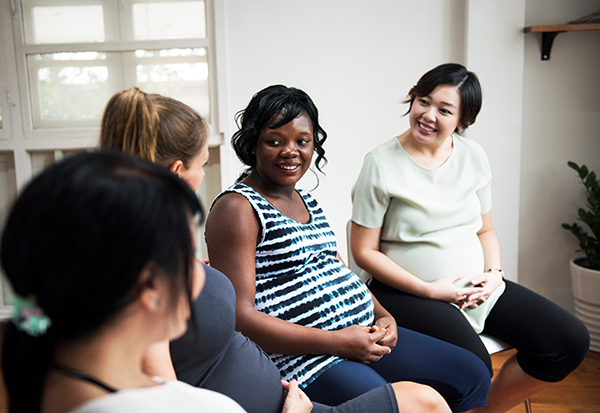
A young mother in our communications office recently shared a story about her grandmother, who lived in a rural area of Vietnam. The community had no running water, and most homes had dirt floors. With little or no access to healthcare, pregnant women gave birth at home, often assisted by the local midwife or another “experienced” woman, like the grandmother. Often, this “experience” amounted to little more than surviving childbirth herself. The grandmother’s advice to young, pregnant women was simple: to make delivery easier, aim to have a small baby by not overeating. While this advice runs counter to what we know about prenatal care and nutrition, it speaks to a basic, yet overlooked truth—women had to first survive delivery, without the help of a medical team or the option for an emergency cesarean section or other intervention.
While maternal deaths (also called maternal mortality) were common in such settings 50 years ago, pregnant women around the world, especially those who live in low-resource areas, continue to face life-threatening complications. The World Health Organization estimates that every day, 830 women die from preventable causes related to pregnancy and childbirth. And while it is easy to think that these problems happen elsewhere, the United States has one of the worst maternal death rates in the developed world. The Centers for Disease Control and Prevention estimates that 700 women die each year in the United States as a result of pregnancy or delivery complications. Death rates are higher among women of color, and even celebrity status and wealth aren’t enough to insulate women from these pregnancy-related health threats, as tennis champion Serena Williams and singer/songwriter Beyoncé have recently shared.
The Eunice Kennedy Shriver National Institute of Child Health and Human Development (NICHD), part of the National Institutes of Health, was founded more than 50 years ago specifically to understand and improve maternal health and pregnancy outcomes. NICHD research even led to the development of the first home pregnancy test in the 1970s.
Maternal mortality doesn’t occur in a vacuum, so studies of how to prevent them can’t either. These deaths result from a pregnancy complication, a chain of medical events started by the pregnancy, worsening of an unrelated condition because of the pregnancy, and other factors. They may occur during pregnancy, childbirth, in the 48 hours immediately following childbirth, or up to 6 weeks after the pregnancy ends. Complications that do not result in death may cause short or long-term health problems or disability, also called maternal morbidity, which can deeply affect a woman’s subsequent quality of life. A full spectrum of research is needed to better understand the causes of these deaths, the situations that contribute to these deaths, and how to treat and prevent them, both in the United States and around the world.
NICHD has a long history of research contributions aimed at reducing maternal morbidity and mortality. For example, today women at high-risk for preeclampsia (very high blood pressure usually starting after 20 weeks of pregnancy) may prevent the condition by taking low-dose aspirin. NICHD-funded researchers found that vaginal birth after a prior C-section—commonly called VBAC—is safe under certain situations and leads to lower infection risk and faster recovery. An NICHD-supported network helped establish that a low-cost drug, called misoprostol, prevents maternal hemorrhage (extreme bleeding) after delivery, saving countless lives in the developing world.
However, there is still a lot that needs to be done, not only to understand the biomedical causes of maternal mortality, but to understand the full social and behavioral contexts of these deaths. In the biomedical realm, ongoing projects include PregSource® (an online effort to gather data directly from pregnant women), translating initial preeclampsia treatment successes into the clinic, and understanding the structure of the cervix and how it changes throughout pregnancy.
In spring 2019, NICHD will lead two national meetings to gather information on the contexts of maternal mortality. The first meeting, scheduled for April, is a community engagement forum with representatives from community-based and professional health groups, where we aim to spark discussion, promote collaborations, and hear from communities on what is needed to help families. Feedback gathered from this meeting will be incorporated into the second meeting, to be held in May, which will focus on the evidence for preventing maternal mortality and treating complications of pregnancy. The goal of this meeting is to establish a new national research agenda on maternal mortality.
We welcome your participation to help us fully understand maternal mortality. You can tune in to the April community engagement forum, which will be streamed online. A Facebook Live portion of the meeting will allow you to ask questions and make comments directly to community leaders. You can also comment, give suggestions, and ask questions at any time through our social media platforms.
We also encourage pregnant women and healthcare providers to work together. Women should start getting prenatal care as early in pregnancy as possible and be honest with their providers about their health and habits. Providers should listen to women, especially if they have health factors that increase the risk of poor outcomes. The team approach has never been more important.
Any maternal death is one too many. It shouldn’t happen in the United States or anywhere else. Let’s work together to figure out how we can make a difference for every expectant woman and her family. Our future depends on it.
 BACK TO TOP
BACK TO TOP